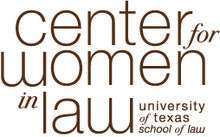Center for Women in Law

The US Center for Women in Law, set up and funded by women, says it is "devoted to the success of the entire spectrum of women in law ... serves as a national resource to convene leaders, generate ideas, and lead change".[1] It says that it combines theory with practice, addressing issues facing individuals and the profession as a whole. The Center is a Vision 2020 National Ally.[2]
Founding
The Center was founded in 2008 by a group of women, many of whom were alumnae of The University of Texas School of Law, and many of whom graduated from law school in earlier decades when it was not common for women to pursue law as a career. The group began discussing the issues faced by women lawyers and became determined to understand fully and address effectively the underlying causes of the barriers to advancement faced by women lawyers. These early conversations ultimately led to the creation of the Center for Women in Law. The Founding Members provided the Center with initial funding toward its endowment, and the purpose to improve the status of all women in law.
Mission
Under the leadership of Executive Director Linda Bray Chanow,[3] the Center states that its mission is to serve as a national resource to convene leaders, generate ideas, and lead change, and that it advocates for significant and lasting changes in the law and the practice by:
- building a national movement by facilitating strategic partnerships through its Consortium for Advancing Women Lawyers;
- providing leadership programs that position women lawyers for success at all stages in their careers;
- promoting best practices for advancing women in law firms, businesses, and other organizations;
- advocating for creative solutions that allow women to raise families while building legal careers;
- providing a center for academic research;
- serving as a resource to law firms, businesses, and other organizations across Texas and throughout the U.S.
The Austin Manifesto
The Austin Manifesto[4] was adopted by acclamation at the 2009 Women’s Power Summit on Law and Leadership, sponsored by the Center for Women in Law at The University of Texas School of Law, on May 1, 2009. The Austin Manifesto calls for specific, concrete steps to tackle the obstacles facing women in the legal profession today. A priority of the Center is gathering information on the steps taken by the signatories and measuring progress pursuant to the Manifesto. The Center will present these findings at its next Power Summit.
Consortium for Advancing Women Lawyers
The Center created the Consortium for Advancing Women Lawyers, which provides the platform to support a national movement by bringing together thought leaders from across the country. Through twice-annual meetings, the leaders share knowledge, develop synergies, and enhance efforts to advance women leaders in the legal profession.
The Women’s Power Summit on Law & Leadership
The Women’s Power Summit on Law and Leadership is a private three-day gathering of women in law, ranging from those at the highest echelons of private practice and the corporate sector to their counterparts in government, non-profits, academia, and the judiciary. The Power Summit features speakers and panel discussions on a variety of topics affecting women within the legal profession. Participants share information, assess the progress that has been made, identify the end goals, network, and set an agenda for future change. The Power Summit is held every two years.
2009 Women's Power Summit
The Inaugural Power Summit was held April 29, 2009 - May 1, 2009[5] and culminated in the drafting and introduction of the Austin Manifesto on Women in Law, a statement of principles and pledges designed to address the myriad of obstacles facing women in the legal profession today. Justice Sandra Day O’Connor was the keynote speaker.
2011 Women's Power Summit
On April 27–29, the Center for Women in Law convened 150 women leaders in the legal profession for an examination of power and leadership. Law school deans, general counsel, federal and state judges, members of law firm management, and government officials attended the Center’s 2011 Women’s Power Summit on Law and Leadership, marking the second time women leaders gathered in Austin to address issues of vital importance to women lawyers.[6]
“The inaugural Women’s Power Summit in 2009 launched the Austin Manifesto, a blueprint for achieving parity in the legal profession,” explained Linda Bray Chanow, the Executive Director of the Center for Women in Law. “The 2011 Women’s Power Summit built upon the historic work of the 2009 Summit by providing a venue for serious dialogue on how women lawyers can use their individual and collective power to achieve the goals articulated in the Manifesto.” [7]
References
- ↑ http://www.utexas.edu/law/centers/cwil/about-the-center/
- ↑ Drexel University, College of Medicine, Vision 2020: national Allies - Center for Women in Law. "Vision 2020 is a national coalition of organizations and individuals united in the commitment to achieve women’s economic and social equality. It was founded and administered by the Institute for Women's Health and Leadership at Drexel University College of Medicine."
- ↑ http://www.utexas.edu/law/centers/cwil/executive-director/
- ↑ http://www.utexas.edu/law/centers/cwil/the-austin-manifesto/
- ↑ http://www.utexas.edu/law/centers/cwil/cwl-events/2009-summit/
- ↑ http://www.utexas.edu/law/centers/cwil/events/2011-summit/
- ↑ http://www.utexas.edu/law/centers/cwil/2011/05/center-for-women-in-law-convenes-women-leaders-for-an-unprecedented-examination-of-power-and-leadership/